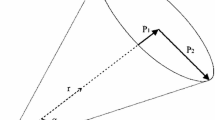Abstract
We develop the theory of convex polyhedral cones in the objective-function space of a multicriteria decision problem. The convex cones are obtained from the decision-maker's pairwise judgments of decision alternatives and are applicable to any quasiconcave utility function. Therefore, the cones can be used in any progressively articulated solution procedure that employs pairwise comparisons. The cones represent convex sets of solutions that are inferior to known solutions to a multicriteria problem. Therefore, these convex sets can be eliminated from consideration while solving the problem. We develop the underlying theory and a framework for representing knowledge about the decision-maker's preference structure using convex cones. This framework can be adopted in the interactive solution of any multicriteria problem after taking into account the characteristics of the problem and the solution procedure. Our computational experience with different multicriteria problems shows that this approach is both viable and efficient in solving practical problems of moderate size.
Similar content being viewed by others
References
R. Benayoun, J. DeMontgolfier, J. Tergny and O. Larichev, Linear programming with multiple objective functions, step method (STEM), Mathematical Programming, 1, No. 3 (1971).
L.G. Chalmet, L. Lemonidis and D.J. Elzinga, An algorithm for the bi-criterion integer programming problem, European Journal of Operations Research 25, No. 2 (1986) 292–300.
V. Chankong and Y.Y. Haimes, The interactive surrogate worth trade-off (ISWT) method for multiobjective decision-making,Vol. of Multicriteria Problem Solving (Springer-Verlag, New York, 1978).
D. Deshpande, Investigations in multiple objective linear programming — theory and an application, Unpublished Doctoral Dissertation, School of Management, State University of New York at Buffalo, 1980.
G.W. Evants, An overview of techniques for solving multiobjective mathematical programs, Management Science 30, No. 11 (1984).
P.H. Farquhar, Utility assessment methods: state of the art, Management Science 30, No. 11 (1984).
D. Gabbani and M.J. Magazine, An interactive heuristic approach for multi-objective integer programming problems, Journal of Operational Research Society 37 (1986) 285–291.
A. Goicochea, D. Hansen and L. Duckstein,Multiobjective Decision Analysis With Engineering and Business Applications (John Wiley and Sons, New York, 1982).
A.M. Geoffrion, J.S. Dyer and A. Feinberg, An interactive approach for multicriterion optimization with an application to the operations of an academic department, Management Science 19 (1972).
G.B. Hazen, Partial information, dominance and potential optimality in multiattribute utility theory, Operations Research 34 (1986) 296–310.
M.H. Karwan, S. Zionts, B. Villareal and R. Ramesh, An improved interactive multicriteria integer programming algorithm, in:Decision Making with Multiple Objectives, eds. Y.Y. Haimes and V. Chankong. Lecture Notes in Economics and Mathematical Systems (Springer-Verlag, 1985).
R.L. Keeney and H. Raiffa,Decisions with multiple objectives: Preferences and Value Tradeoffs (John Wiley and Sons, New York, 1976).
C.W. Kirkwood and R.K. Sarin, Ranking with partial information: a method and an application, Operations Research 33 (1985) 38–48.
M. Koksalen, Multiple criteria decision making with discrete alternatives, Unpublished doctoral dissertation, Department of Industrial Engineering, State University of New York at Buffal, 1984.
M. Koksalen, M.H. Karwan and S. Zionts, An improved method for solving multiple criteria problems involving discrete alternatives, IEEE Transactions on Systems, Man and Cybernetics, Vol. SMC-14, No. 1 (1984).
P. Korhonen, J. Wallenius and S. Zionts, Solving the discrete multiple criteria problem using convex cones, Management Science 30, No. 11 (1984).
R. Ramesh, Multicriteria integer programming, Unpublished Doctoral Dissertation, Department of Industrial Engineering, State University of New York at Buffalo, 1985.
R. Ramesh, M.H. Karwan and S. Zionts, A class of practical interactive branch and bound algorithms for multicriteria integer programming, European Journal of Operations Research, 26, No. 1 (1986).
R. Ramesh, M.H. Karwan and S. Zionts, Preference structure representation using convex cones in multicriteria integer programming, Working Paper No. 646, School of Management, State University of New York at Buffalo, 1985.
R. Ramesh, M.H. Karwan and S. Zionts, An efficient interactive solution framęwork for bicriteria integer programming, Working Paper No. 668, School of Management, State University of New York at Buffalo, 1986.
T.L. Saaty, A scaling method for properties of hierarchies, Journal of Mathematical Psychology 15, No. 3 (1977).
R.K. Sarin, Interactive evaluation and bound procedure for selecting multi-attributed alternatives, TIMS Studies in Management Science (1977) 211–224.
R.E. Steuer, Multiple objective linear programming with interval criterion weights, Management Science 23 (1976).
R.E. Steuer and E.U. Choo, An interactive weighted Tchebycheff procedure for multiple objective programming, Mathematical Programming 26 (1983).
M. Weber, A method of multiattribute decision making with incomplete information, Management Science 31 (1985) 1365–1371.
D.J. White, Multi-objective interactive programming, Journal of Operational Research Society 31 (1980).
S. Zionts, A survey of multiple criteria integer programming methods, Annals of Discrete Mathematics 5 (1979).
S. Zionts and J. Wallenius, An interactive programming method for solving the multiple criteria problem, Management Science 22, No. 6 (1976).
S. Zionts and J. Wallenius, Identifying efficient vectors: some theory and computational results, Operations Research 28, No. 3 (1980).
S. Zionts and J. Wallenius, An interactive multiple objective linear programming method for a class of underlying nonlinear utility functions, Management Science 29, No. 5 (1983).
Author information
Authors and Affiliations
Rights and permissions
About this article
Cite this article
Ramesh, R., Karwan, M.H. & Zionts, S. Theory of convex cones in multicriteria decision making. Ann Oper Res 16, 131–147 (1988). https://doi.org/10.1007/BF02283741
Issue Date:
DOI: https://doi.org/10.1007/BF02283741




